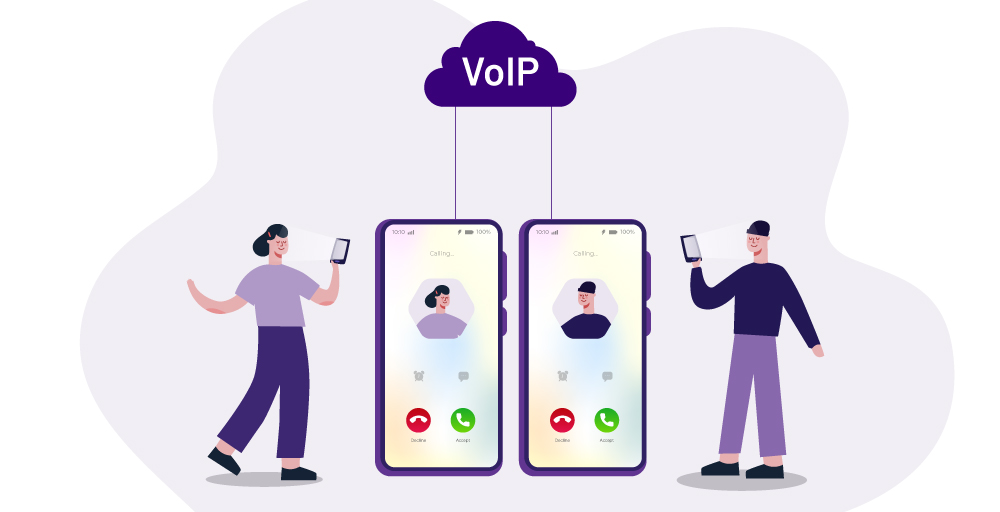Even though VoIP phone systems are highly reliable, VoIP calls are still prone to network congestion. Issues such as jitter, latency, and packet loss result in low audio quality, delayed audio, dropped calls, and so on.
All of these interference prevents your team from offering uninterrupted and high-quality service. But, what exactly is VoIP QoS 🤔, and what does it do for VoIP phone systems?
This article will help you understand everything about VoIP QoS: what it is, why it matters, its benefits and limitations, benchmarks, how you can adjust it, and best practices.
🔑 KEY HIGHLIGHTS
- VoIP QoS prioritizes voice call data packets to prevent issues like jitter, latency, and packet loss from affecting call quality.
- Common issues addressed by QoS include high latency, jitter, dropped calls, echoes, and delays.
- QoS requirements, such as less than 1-2% packet loss, latency under 150ms, and jitter under 30ms, aim to improve call quality.
- QoS is adjusted by changing router settings to prioritize VoIP traffic, such as marking calls with “highest priority” or the DSCP value EF(46).
- A strong QoS guarantees minimal disruptions, fast speeds, low latency, and clear communication for a positive customer experience.
What is VoIP QoS?
VoIP QoS is a way for routers to prioritize different types of network traffic, such as VoIP calls. With VoIP, calls are sent through the Internet in small data packets. These packets need to get to where they’re going on time and in the right order.

If packets are late or mixed up, it can cause problems for businesses making calls. Things like long wait times and dropped calls happen. QoS helps fix this by making sure voice call data gets through the network before other types of traffic. This prevents issues that reduce call quality, such as echoes, delays, and calls disconnecting.
What is a QoS requirement for voip calls?
QoS or Quality of Service requirement for VoIP calls involves ensuring that your infrastructure meets specific criteria to enhance voice quality. This includes minimizing latency, jitter, and preventing packet loss.
For smooth VoIP call quality, you’ll need your service provider’s support, enough bandwidth that meets the standards, and router settings that are set up properly to prioritize network traffic and keep the call quality high.
By implementing QoS, you can make the most of your bandwidth, prioritize voice traffic, and cut down on problems like latency, jitter, and packet loss. This means your VoIP calls will be smooth and uninterrupted.
Why does a Quality of Service (QoS) matter?
Good VoIP quality of service (QoS) is important for businesses. It can help in several key ways:
- Quality of Service optimizes how the network works and makes better use of bandwidth on the internet.
- QoS prioritizes voice calls to make sure they happen on time and are clear.
- It improves reliability and call quality.
- QoS reduces dropped calls and situations where call quality is poor.
- It enhances call quality for everyone connected to the office wifi network.
Without good QoS, customers may lose trust in the company if calls are always bad. Things like communication failures and poor productivity can hurt businesses. Effective QoS helps prevent these problems and keep work running smoothly whether people are in the office or working from home.
Benefits & Limitations of VoIP Quality of Service
VoIP QoS is an excellent tool that can benefit a company in many ways. However, it also has its limitations. Let’s look at some of its benefits as well as its limitations.
Benefits
- Crystal clear calls: QoS makes sure voice data is the top priority. This cuts down on lags, glitches, and lost data packets. Calls have fewer disruptions and become smoother and clearer.
- Reliable connections: Qos VoIP offers reliable connections by prioritizing VoIP traffic. It limits how much a busy network can reduce your call quality. With Qos VoIP, dropped calls become much less of a problem.
- Efficient bandwidth: Bandwidth is allocated for VoIP sensibly so other activities don’t steal what calls need. This ensures smooth calls even on slower internet connections.
- Easy troubleshooting: Built-in monitors help quickly figure out any issues anywhere in the whole calling system. Admins get right on fixing problems before users notice downtime.
Limitations
- Varied Network Environments: Balancing QoS for VoIP can be tough in varied network setups. While organizations have control over their Local Area Network (LAN), the broader Wide Area Network (WAN) is usually out of their hands. This makes it tricky to ensure consistent QoS across the entire network, posing challenges for reliability.
- Other device usage matters too: Even with QoS, devices downloading or streaming videos on the same internet connection might slow down calls. Uploading big files or watching videos takes up bandwidth, which is needed for calls.
- Old equipment limits QoS: Really old routers or switches might not support the latest QoS features well. Calls may still have problems on networks with very outdated Internet gear that QoS can’t fully use.
- Internet dependency: No matter what you do, your internet provider ultimately controls your connection quality. During peak hours, when the whole network gets crowded, not even QoS can fix issues caused by an overloaded provider network. QoS works best when other networks, like your provider’s, have lots of spare bandwidth.
How Does QoS Work for VoIP?
Quality of Service (QoS) for Voice over Internet Protocol (VoIP) works by prioritizing network traffic and managing it to provide consistent and high-quality calls. Since VoIP is a real-time application, it is sensitive to manage latency, jitter, and lost data packets.
QoS addresses these factors by optimizing the network specifically for VoIP traffic. Things like prioritizing VoIP data and managing bandwidth help ensure smooth, high-quality calls even when network issues would otherwise affect call quality without QoS implemented.
How to set up QoS for VoIP?
Try these steps to set up QoS on your VoIP phone. Also, fixing jitter or call quality issues takes some trial and error. If you need extra help, talk to your phone service tech experts.
- First, see if your router or internet company sets any limits on how much bandwidth each device gets. These help keep the internet running well for everyone.
- Talk to others using your network about saving bandwidth during work hours. Streaming videos or playing online games uses a lot of bandwidth, which otherwise can help improve calls.
- Use the priority queue if your router allows it. Turning this on puts calls at the front of the line, so you get the most from any bandwidth caps while keeping call quality high.
These steps can optimize your network for making calls. However, full fixes may require your provider’s specialized knowledge. Don’t be afraid to ask them for help if simple changes don’t work. Working with them can get your calls running perfectly.
Understanding VoIP QoS Benchmarks
VoIP QoS is evaluated according to four key metrics, which are:
Latency
When you make an internet call, there is always going to be some delay between when the person speaks and when their voice reaches the receiver. This delay is called latency. Latency is measured by how many milliseconds (ms) it takes for the voice data to travel from the caller to the person on the other end. The shorter this time, the better the call quality.
The latency for calls within the same country is usually between 100 and 150 ms. Anything under 70 ms is considered really good quality. Calls between places farther apart will naturally have more latency. International calls might have latency ranging from 250 to 350 ms.
Packet loss
When you make a phone call over the internet, the voice data has to be sent in chunks. These chunks are called packets. To send the packets across the net, the data first has to be broken apart into little pieces that can be easily read and sorted by routers and servers.
Once all the packets make it to the receiving end, they have to be put back together again to reconstruct the original voice data. But sometimes, during transmission, a few packets go missing. This is called packet loss.
Jitter
A jitter is the amount of time it takes for packets of information to travel from the sender to the receiver during an online phone call. The packets are meant to arrive at steady, consistent intervals and in the correct order.
However, sometimes, things can cause the timing to become uneven. The network cables or wireless connection might change routes, some packets could get lost along the way, or there could be too much traffic clogging up the network.
Mean Opinion Score (MOS)
The last thing we look at is called the MOS score. MOS stands for Mean Opinion Score. Basically, after people make phone calls using the internet service, they get asked to rate their experience on a scale of 1 to 5.
Firstly, 1 means really bad quality, and 5 means the call is excellent call quality. This scoring system isn’t very scientific or standardized – it just relies on people’s own opinions. But it’s actually the most important metric to pay attention to.
How can you adjust VoIP Quality of Service Settings?
In most cases, the VoIP Quality of Service is adjusted by changing the router’s settings. Here is a general guideline on how you can do that:
Adjusting VoIP Quality of Service (QoS) settings usually means changing your router’s settings. What you do depends on your specific router. In any case, here is a general guideline:
- Firstly, write down your router’s IP address (something like 192.168.1.1) in your browser’s address bar. Then log in using your router’s username and password.
- Next, look through the menus for the Quality of Service (QoS) section. This section controls how data is prioritized in your network.
- Turn on your router’s QoS feature so it can prioritize phone calls.
- Then, set your calls to be the “highest priority” data type. You can do this either by marking calls specifically on the type (e.g., VoIP) or by setting their “DSCP value” to EF (46), which is commonly used for VoIP traffic.
Some routers have advanced options too, such as bandwidth reservation or strict priority queuing, but start simply by just enabling QoS and prioritizing calls. Check if your calls work better then.
Don’t forget to check your router’s manual if you get stuck. Or ask your phone provider – they might know the best settings for your network setup. Taking it step-by-step is easiest when adjusting QoS settings.
VoIP QoS Best Practices
Start by learning how your VoIP system works since every network and router configuration is different. Read the instructions, guides, and manuals from your VoIP provider to understand how it functions and how to reduce network congestion.
Do your research on common network benchmarks so you can pinpoint any issues and troubleshoot effectively.
To know the ideal metrics, Cisco recommends this:
- Packet loss under 1% to prevent audio errors, with no loss for VoIP.
- Delay in real-time voice traffic should be under 150ms one-way.
- Jitter should also be minimized as it adds to the delay.
Research shows the most important Quality of Service metrics are jitter, bandwidth, and voip packet loss. Getting familiar with these benchmarks will help you optimize your VoIP solution for clear call quality by prioritizing voice traffic on your network.
Look into other benchmarks besides the typical ones to further enhance call quality, which are:
- Prioritize network traffic by type, not device, so bandwidth is used wisely. Manage each connected device’s bandwidth separately since queuing depends on the nature of the traffic.
- If your VoIP phone has a DSCP header, assign high priority to that traffic. Remember to configure both incoming and outgoing RTP packets with DSCP 46 to utilize your DSCP 46 system fully.
- Use advanced queuing techniques like setting trusted mode on switches so they easily recognize DSCP packets.
- Choose a business VoIP provider that is reputable, experienced, and reliable. They should customize solutions to your needs and regularly provide expertise on optimizing call quality.
- Go with wired Ethernet, instead of WiFi since it offers lower latency and reduced risk of disconnected calls.
- Regularly test your local area network and wide area network connections to monitor metrics like ping and jitter, preemptively addressing congestion issues.
KrispCall: Advanced VoIP Quality of Service Provider
QoS is critical in a VoIP network to improve support and the user experience. This means choosing a provider with strong infrastructure and networking. One top option is KrispCall. Not only does it offer full VoIP capabilities, but it also provides things like great uptime guarantees and a worldwide network.
In addition, KrispCall offers advanced features such as automatic call distribution, number porting, global reach, and many more. These advanced features enhance communication, streamline call management, and bolster collaboration for both businesses and individuals using their VoIP services, resulting in a seamless experience.
Book a demo with KrispCall today and find out why top enterprises trust KrispCall for their communication needs.
Conclusion
Quality of Service is an integral part of business communication. It prioritizes voice traffic on your network, enables smooth call experiences, and eliminates jittery connections and packet loss. Remember, a well-configured VoIP system with QoS enabled can significantly enhance your team’s communication and collaboration.
This ultimately helps increase your agent productivity and improve customer satisfaction. Whether you’re a small business owner or a large enterprise, signing up to KrispCall to prioritize VoIP QoS is an investment in clear communication and a more productive work environment.
FAQs
What is the importance of Quality of Service (QoS) in VOIP Communication?
Quality of Service (QoS) is extremely important in VoIP communication to ensure call quality, bandwidth management, compliance and regulatory requirements, and many more.
What are the popular QoS Monitoring Tools?
Some of the popular QoS monitoring tools are:
1. Auvik
2. SolarWinds Network Performance Monitor
3. Paessler PRTG Network Monitor
4. SuperOps
5. AKIPS
What are the factors measured in a VoIP QoS Test?
The main factors measured in a VoIP QoS test are:
1. Latency
2. Jitter
3. Packet loss
4. Mean Opinion Score (MOS)
How does a VoIP issue arise?
Many factors contribute to issues that may arise in VoIP. Some of them include network overload, bandwidth limitations, distance limitations, server issues, and power disruptions.
Are there any standards for VoIP QoS?
Yes, there are standards for VoIP Quality of Service. Keeping packet loss extremely low, latency under 150 ms one-way, and jitter below 100 ms are the standards that allow VoIP to outperform traditional telephone networks and ensure the clearest, highest-quality calls.
How does QoS improve customer experience?
A strong QoS guarantees minimal interruptions, quick Internet speeds, low delay, and clear audio/video quality – all of which are absolutely essential for a good experience with phone, video, and data services.





